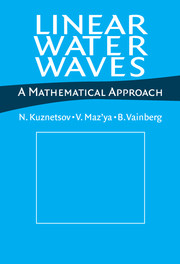Introduction: Basic Theory of Surface Waves
Published online by Cambridge University Press: 14 October 2009
Summary
Here we give a brief account of physical assumptions (first section) and the mathematical approximation (second section) used for developing a mathematical model of water waves. The resulting linear boundary value problems are formulated in the third and fourth sections for the wave-body interaction and ship waves, respectively.
Mathematical Formulation
Conventions
Water waves (the terms surface waves and gravity waves are also in use) are created normally by a gravitational force in the presence of a free surface along which the pressure is constant. There are two ways to describe these waves mathematically. It is possible to trace the paths of individual particles (a Lagrangian description), but in this book an alternative form of equations (usually referred to as Eulerian) is adopted. The motion is determined by the velocity field in the domain occupied by water at every moment of the time t.
Water is assumed to occupy a certain domain W bounded by one or more moving or fixed surfaces that separate water from some other medium. Actually we consider boundaries of two types: the above-mentioned free surface separating water from the atmosphere, and rigid surfaces including the bottom and surfaces of bodies floating in and/or beneath the free surface.
It is convenient to use rectangular coordinates (x1, x2, y) with origin in the free surface at rest (which usually coincides with the mean free surface), and with the y axis directed opposite to the acceleration caused by gravity.
- Type
- Chapter
- Information
- Linear Water WavesA Mathematical Approach, pp. 1 - 18Publisher: Cambridge University PressPrint publication year: 2002

